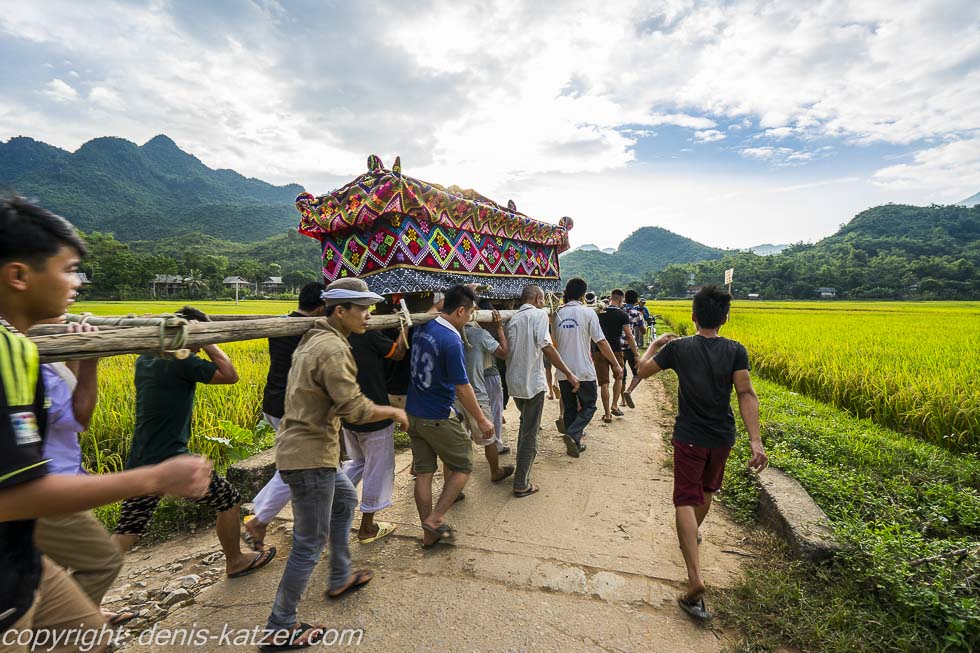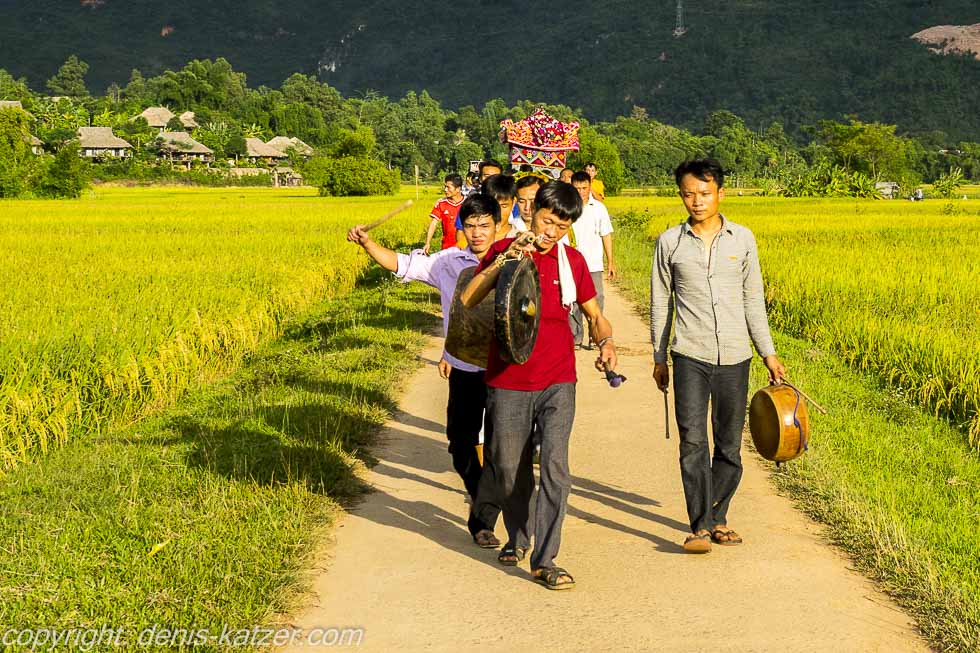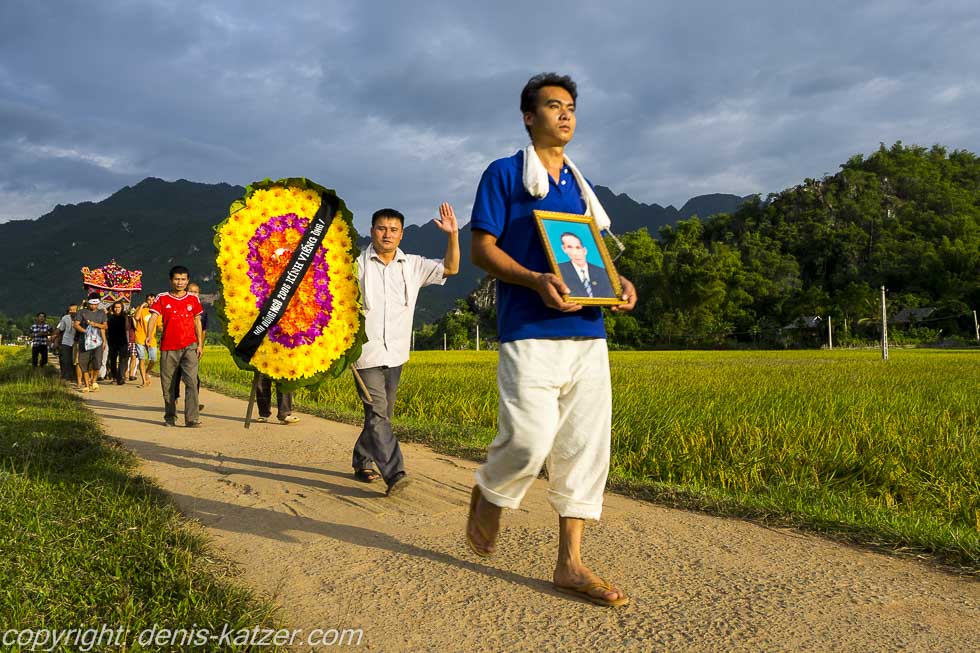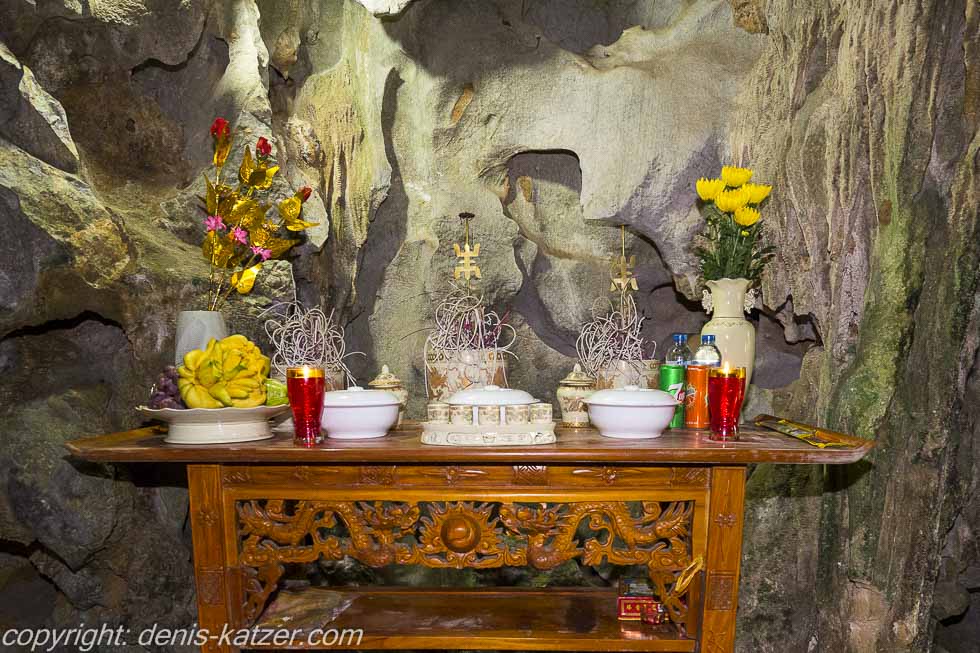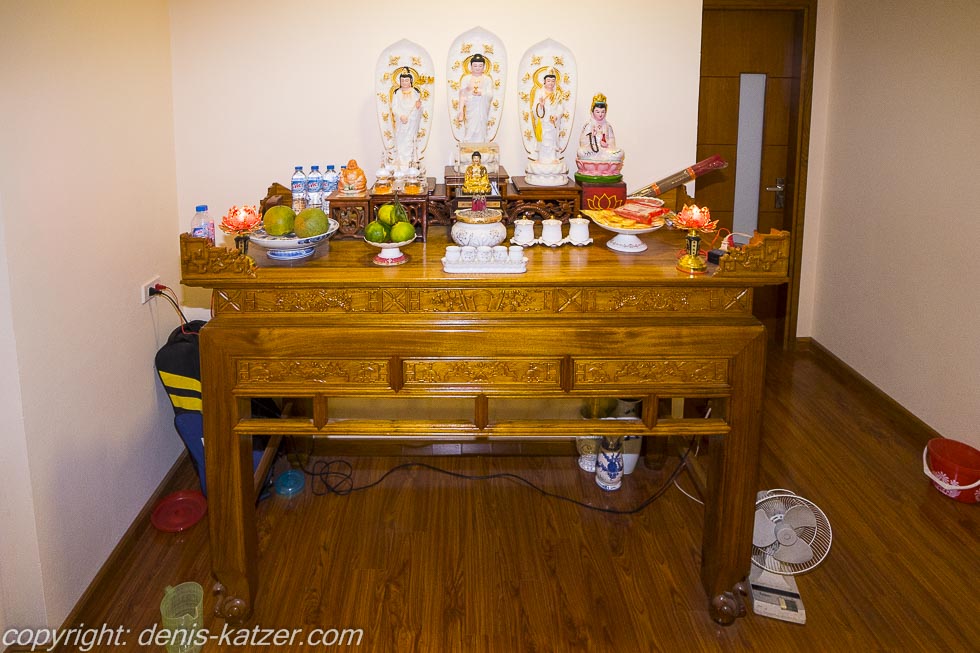
Ancestor worship
N 20°39'00.0'' E 105°05'00.0''
Date:
27.09.2016 until 05.10.2016
Day: 459 – 468
Country:
Vietnam
Province:
Hòa Bình
Location:
May Chau
Latitude N:
20°39’00.0”
Longitude E:
105°05’00.0”
Daily kilometers:
310 km covered by bus
Total kilometers:
19.181
Soil condition:
Asphalt
Total altitude meters:
54.661 m
Sunrise:
05:49 – 05:51
Sunset:
5:52 pm – 5:44 pm
Temperature day max:
33°C
Temperature day min:
24°C
(Photos of the diary entry can be found at the end of the text).
Before we know it, we end up back in our Mai Chau. Ka, the manager, reserved our lovely room. The staff bring our saddlebags, which were temporarily stored in the kitchen. We quickly tidied it up again and settled in.
Now that the frame of my bike has been welded again and everything else is in order, we are finally working on continuing our journey in the next few days. “And you’re sure that your shoulder is stable enough?” asks Tanja. “I think so. The bone that’s still sticking out looks bad, but I think I’ll have to put up with it. However, it still hurts, especially when I lift my arm. Nevertheless, it should be fine. We can’t stay here forever.” “We’ll stay until you’re fit again.” “I’m fit and if I find that the pain is getting too much, we’ll have to take another break somewhere else.” “Okay, how far is it to the border again?” “About 500 kilometers. We have to be there in just under 2 ½ weeks. I’ll use a few more days here to write down our experiences of Halong Bay and archive the pictures and then we should get going,” I suggest. “I think so too. Will we actually pass the dry Halong Bay on our way to the border?” “It’s a detour of over 100 kilometers. We won’t make it,” I think, studying the map. “What a shame, the caves that you can row through in small boats must be uniquely beautiful.” “Oh, I’d forgotten that there are these caves near Nin Binh. I would have loved to visit them too,” I say. “Then we’d have to leave tomorrow,” Tanja interjects. “That’s right. Phew, that’s a bit sudden. Do you feel like driving on tomorrow?” “Not really.” “And above all, we wanted to sit down with Hai, Hung, Two and Manh Do to talk about the elephant trip. Hai, with his direct contact to the President of Vietnam, could help us enormously in this matter. Maybe the government will get involved in this project?” “If we leave tomorrow, we’ll have to skip the meeting,” Tanja concludes. “Not a good idea.” “Absolutely not a good idea.” “Do you have a solution?” I ask. “Hm, maybe.” “Let’s hear it.” “We could store our things here again, take a bus with light luggage to Nin Bihn, see the area with all the sights and come back here on the bus. Then we could take the bus to the border crossing that Manh Do suggested. He was talking about a border crossing that is only about 140 kilometers from here, wasn’t he?” “Yes, he mentioned the border crossing on the way back from Hanoi. I was already thinking about whether we should go there on our bikes. But Manh said that large sections of the road were just being built and that we would sink into the mud with our bikes on this stretch. Besides, it’s not in the direction we want to travel, but rather to the south-east.” “That’s what I mean. We’ll get a bus to take us there, cross the border, come back and then set off. So you’ll have a few more writing days here, we’ll see the caves at Nin Binh and have our new visas in our pockets. All without any stress.” I think about Tanja’s plan. “You’re great. The plan sounds great. That’s exactly how we’ll do it. In addition, my shoulder can regenerate a little better until we’re back on the bike every day. A really fantastic plan,” I praise Tanja and instantly feel the burgeoning stress of an imminent departure fall from my shoulders.
Boom! Boom! Boom! A louder drum sounds. “Denis, you have to see this! There’s a funeral procession approaching,” shouts Tanja, rushing into the room. “Do you think so?” I ask hesitantly, as I’m sitting at my laptop writing about the experiences of the last few days. “But yes. Come to the balcony quickly.” “I immediately grab the camera and rush outside. Sure enough, a funeral procession is marching past our resort. I think about going downstairs to take a few pictures, but I don’t want to disturb the mourning guests. Moments later, I spot familiar faces of the hotel staff among the pallbearers. As I stand on the path and look towards them, some of the people smile at me in a friendly manner. Of course, everyone here is from the valley and as we have been staying here for 2 ½ months, almost everyone knows me. Losing my shyness, I now run after the mourners. Many of the bearers must have had a few too many glasses of rice wine during the funeral service. Their exhalations at least suggest that. “Come help us carry!” shouts one of the pallbearers. “Is he serious?” I wonder. “Come on, then. There’s still room under the coffin,” he urges me again. “I shake my head with a laugh. Firstly, I’m not part of the grieving community and secondly, I couldn’t help with my injured shoulder even if I wanted to. In Asia, funerals are usually anything but quiet, dark and depressing ceremonies. Quite the opposite. However, funerals are no cause for merriment here either, because the loss of close relatives is just as painful in Vietnam as anywhere else in the world.
I hurry forward to take a few pictures from a different perspective. The late afternoon sun casts its warm, golden rays over the rice fields, which are harvested piece by piece at this time of year. The coffin, decorated with colorful fabrics, shines in all colors and contrasts with the lush green rice plants. If it wasn’t a sad occasion, the little funeral procession would have something nice about it. The pallbearers are led by two drummers and a flautist, followed by a young man holding a photo of the deceased in his hands, another man constantly reaching into a bag, pulling out paper money and snippets to throw into the air. According to the beliefs of these people, the deceased will later find his way back from the cemetery to his house. Most ethnic peoples in Vietnam have their own death rituals. This also applies to the white Thai, H’mong, Zao, Muong, Tay, Hoa and Kinh in Mai Chau. The Kinh, who make up the largest population group in Vietnam with 88%, follow an idiosyncratic cult in which they dig up, clean and rebury the dead after a year.
“The man was our neighbor and was only 50 years old,” says Ka, the manager of the Nature Lodge. “No age,” I say. “No, I hope I make it longer,” he replies with a laugh. “Growing old with dignity is certainly the greatest gift,” I reply and ask Ka about ancestor worship in Vietnam. “We have been celebrating this cult since time immemorial. Not much has changed even today. Everything is governed by rules and rites. It starts with the fact that we have a fortune teller come and determine the exact time for the burial of the deceased. The thầy bói, as the fortune teller is called here, also determines the time at which the deceased is laid in his coffin. Every family here still has old coffins in storage, made from a large hollowed-out log.” “How?” I ask, not understanding. “A large tree is felled, cut into pieces and hollowed out with a lot of work.” “Similar to an aboriginal dugout canoe?” I interject. “Something like this.” “That must be a lot of trees if every dead person is buried in a tree trunk like that. Is that still allowed?” “Because trees are becoming scarce in Vietnam, it’s actually no longer allowed to cut down trees. Nevertheless, many families still have such coffins in stock.” “Awesome,” I say and ask how I should imagine the ancestor cult. “In every house in Vietnam, the family has a small area or room where the ancestral altar is set up. It is a high, wooden table on which we place pictures or, if not available, paintings of our ancestors. Next to it is a container filled with sand into which we put the incense sticks. Then on the “Bàn Thờ”, as we call the ancestral altar, there must be a container of salt, a container of dry rice grains and a porcelain tea set filled with water. It is important to always keep the water fresh. I also have two candlesticks on my altar at home, two vases for flowers and a bowl for the offerings that I will soon be making to the ancestors every day. Rich people like Hung and Hai, for example, place Buddha figures on their “Bàn Thờ”. Some also decorate it with various statues of gods and pictures made of gold, electric candles and glowing water lilies. There are no limits in this respect.” “Quite elaborate. And every Vietnamese has this at home?” “Absolutely. But the poor people only have small altars with less expensive utensils.” “And then you worship the ancestors every day?” “Some certainly do. However, the important days of the month are the first and fifteenth of the lunar calendar. On these two days, we make offerings to our deceased relatives, which we call ‘Thắp Hương’. For example, a small plate with flower heads, some fruit and spirit money.” “Ghost money?” “Yes, it’s paper money that we burn to send to the deceased in the afterlife.” “Does that mean your ancestors need money in the afterlife?” “Ultimately, it’s a symbolic act. We want our ancestors to be well.” “Interesting, and what happens next?” “We light an odd number of incense sticks because an even number would bring bad luck. To do this, we light a cigarette and place it on the stick of an incense stick that has already been used. If the cigarette burns down to the filter and does not lose any ash, this is a good sign. At this point at the latest, we pray to our ancestors and recently deceased relatives. “And what do you pray to relatives?” “Exactly the same as to the gods. For example, we ask for help in difficult life situations, tell them about our worries and hardships. We tell them about our family when someone has a baby, or is facing an important exam, or is ill. Ultimately, you can tell your ancestors everything that worries or delights you. They remain a part of us, even if they are no longer visible to us, we firmly believe that they are still here to protect us.”
“Thank you for your detailed explanation. I knew it was about ancestor worship but had no connection to it. Your explanation has created a bridge of understanding and understanding for me.” “No problem Denis. It gives me pleasure when you are interested in our culture.”…
If you would like to find out more about our adventures, you can find our books under this link.
The live coverage is supported by the companies Gesat GmbH: www.gesat.com and roda computer GmbH http://roda-computer.com/ The satellite telephone Explorer 300 from Gesat and the rugged notebook Pegasus RP9 from Roda are the pillars of the transmission. Pegasus RP9 from Roda are the pillars of the transmission.

